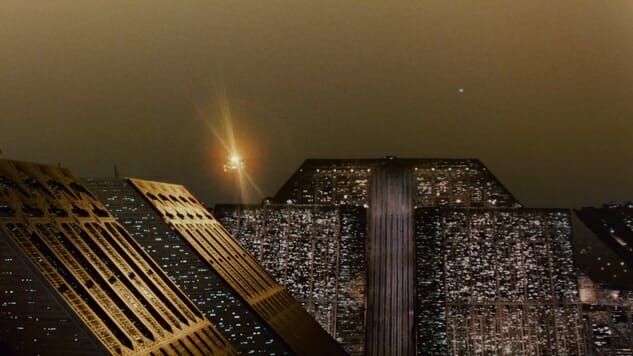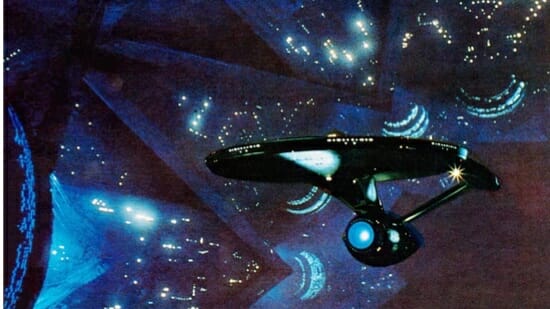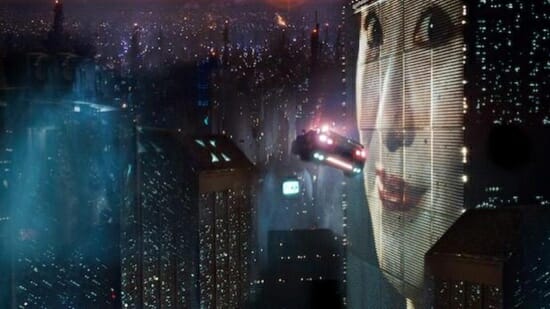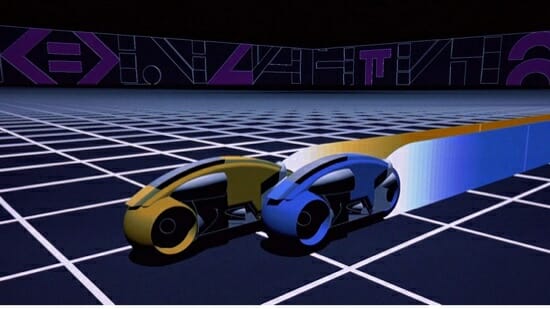Syd Mead Drew Our Future in Glitz and Grime
Revisiting the late artist’s prophetic futurism
Movies Features Syd Mead
Every visual design task carries a lot of unspoken weight, but envisioning the future carries with it a fascinating kind of power: The artist is given free rein to tell a story that has not yet happened, but which he argues may yet. Shading such a vision with one’s own hopes and fears is inevitable, when you think about it. In that regard, some of the late Syd Mead’s most iconic design work was as much a part of defining late 20th century futurism as the directing and scripts of the movies he left his indelible mark upon. Just as it’s impossible to imagine Star Wars or Leone’s Spaghetti Westerns without their respective scores, Mead’s conceptual art work on movies like Blade Runner, Tron and Aliens is inextricable from the “feel” of dystopian science fiction.
One of if not the most important ambassadors of the neo-futurist movement to the silver screen, Mead’s intricate drawings of a world of oddly organic-shaped architecture and machinery set the tone of dystopias that look as if they were built by the affluent to look glitzy, but covered in the grit of a dangerous reality.

While Mead started as a visual artist in the automotive and architectural fields in the ’60s, his first major work as a visual designer came in 1979’s Star Trek: The Motion Picture. The bottomless appetite for space adventure that followed Star Wars arrived just in time for Mead—whose father had raised him on Buck Rogers and Flash Gordon—to be sought after to provide visual styles for the overwhelming dystopias that directors sought to realize. It’s hard to name a movie more indicative of a pivot from older space-age sci-fi to the newer, darker age of sci-fi visual effects that would define the last two decades of the 20th century. Debuting two years after Star Wars completely rewrote what was possible with visual effects, Star Trek felt a world away from its television source material.
Mead would be credited as a “visual futurist” on Blade Runner a few years later, bringing his architectural and automotive design chops to the task of imagining a 21st century Los Angeles that towered over its citizens in a way that mirrored the story’s themes of technology eclipsing humanity.

“I believe [Blade Runner] has survived because it’s a love story, and it has moralistic underpinnings of, if we could make people, would we treat them like a dishwasher?” —Syd Mead, in an interview about designing the world of Blade Runner
Speaking of Blade Runner, which has to be his most iconic work, Mead has been modest, saying it was originally just a design job for him. Nonetheless, it’s clear he knew exactly what he was doing from the start. He has described it as a “nasty” story, and spoken of how he tried to keep a consistent design aesthetic aimed at making a world in which the viewer would never, ever want to live. All of this, he said, was achieved even as he kept getting new and totally out-there directives on how the movie would even begin: At various points, he said, he had created conceptual work for four different opening sequences that had all been scrapped due to practical concerns.
He managed the trick anyhow. Blade Runner, with its coldly functional “spinners” (the flying cars), its gigantic buildings and its cyberpunk populace, became the coolest movie ever, inspiring homage that continues to this day. I’m convinced it wouldn’t have been as well-received nor as obsessed over in the ensuing decades if Mead’s engineering know-how hadn’t been married in his mind to an intuitive understanding of what kind of story his artwork was supposed to be telling. Mead was thinking about why the front wheels of the spinners needed to be separate from one another (how else can the driver look downward while flying?), but he was also thinking about whether an artificial human being would be treated like a dishwasher.

Mead’s other most iconic designs were pegged to films about the same kind of twisted future. In Blade Runner human beings are cranked out on an assembly line. In Aliens, spacecraft and colonies house a gruesome alien that hunts down the hapless employees and grunt soldiers betrayed by their capitalist overlords. In Tron, for which Mead contributed major design concepts for the world inside the computer system, a rogue AI plots against its masters.
There’s a painful twinge of dreadful truth about human nature in his work. The clean lines and curves of his light cycles and office buildings are lying to the viewer, trying to put a pleasant façade on dreamscapes that have gone wrong. Mead essentially authored the chipper corporate façade in a world on fire, that staple of cyberpunk dystopia. One wonders what every third sci-fi videogame would look like without his influence.
The 86-year-old designer’s last words, per his spouse and business partner Roger Servick, were: “I’m done here. They’re coming to take me back.”
Kenneth Lowe is either a benefit or a hazard, if he’s a hazard it’s not your problem. You can follow him on Twitter and read more at his blog.